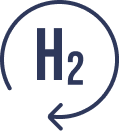Hydrogen
GREEN
Is hydrogen produced through the electrolysis of water powered by renewable energy.

Hydrogen Green
Is hydrogen produced through the electrolysis of water powered by renewable energy.
This molecule
has manyapplications.
Among other:

Replaces conventional hydrogen (gray) obtained through methane reforming.

It is used directly as a green raw material in any chemical process that requires it.

It can replace other fuels in all those industrial processes that need heat

It can replace other fossil fuels in mobility applications (buses, trucks, cars and trains among others).

Can replace natural gas as fuel for the production of electrical energy.

It can be stored and therefore serve as a “seasonal reserve” of energy.
The key to producing competitive green hydrogen is the cost of the electrical energy that powers the electrolysis process and the number of hours that the electrolyzer can operate.
Therefore, it is essential to seek to produce hydrogen in markets where electrical energy is cheap and plant factors high. These markets are typically those with a high penetration of renewables (solar and wind), as is the case of Chile and Spain & Portugal.
Antuko has more
4 GW of electrolysis capacity under development
CHILE
- Project Genesis: 100 MW 100 MW electrolysis intended for hydrogen production to supply local demand in the Norte Grande.
- Project Hydrus: 2 GW de of electrolysis for the production of ammonia and its subsequent export to European and Asian markets.
- Project Circinus: 300 MW of electrolysis intended for the production of hydrogen to supply a purely mining demand, in the Norte Grande.
Península Ibérica
- Project Sidi: 300 MW of electrolysis intended for the production of hydrogen, for subsequent injection into a specific transportation network. Castilla y León.
- Project Numantis: 500 MW of electrolysis for the production of ammonia. Navarre.
- Project Lebeche: 1 GW of electrolysis destined for the production and maritime export of ammonia. Levante.
